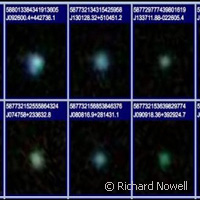'Green Pea' galaxies: updates, and a tribute to citizen science
A contribution to this year's edition of the Joint European and National Astronomy Meeting (JENAM2010) in Lisbon, Portugal has provided updates on the nature of the so-called Green Pea galaxies and acknowledged the crucial role of amateur astronomers in their discovery. Green Pea galaxies were first spotted in 2007 by volunteers enrolled in the online project Galaxy Zoo. Members of the online community had replied to the project's request for help in sifting through a profusion of night sky images produced by the Sloan Digital Sky Survey. Participants were asked to classify galaxies according to a series of criteria, a task that requires human appraisal as the answers are not always clear-cut. Over a quarter million people have taken part in the project so far. Citizen scientists from around the world responded with enthusiasm and were quick to flag up a volley of galaxies with a difference. Small and green, these came to be known as 'Green Peas'. They appear to be compact, low-mass galaxies at a brief, intense stage of their evolution which features high rates of star formation - fertile sources of stars in the making, at a distance of approximately 1.5 to 5 billion light years. Prior to his presentation on 10 September 2010, Ricardo Amorin of the Instituto de Astrofísica de Andalucía in Granada, Spain, said: 'This Green Pea discovery is a fabulous example of how normal citizens, "astronomy lovers", can help scientists with their collective efforts. They discuss the science with professional astronomers, and have written an excellent Wikipedia entry about Green Pea galaxies which presents a lot of information to people of the world.' The classification of galaxies contributes to a body of knowledge which enables researchers to take a closer look at our planetary past. 'Discovering Green Pea galaxies,' said Mr Amorin, 'has opened a new window to investigate galaxy evolution and star formation in the early universe.' Recent findings indicate that these galaxies are poor in elements other than helium and hydrogen, which could be due to dilution by streams of gas and strong supernova winds. In terms of surprises, Galaxy Zoo and Galaxy Zoo 2 (an improved version) have delivered more than Peas. An object noted by a Dutch volunteer in 2007, for example, defied explanation for several years until it was tentatively interpreted as a phenomenon caused by a supermassive black hole in June 2010. Mr Amorin's update on Green Pea galaxies was announced through the media centre of the Europlanet RI ('European planetology network research infrastructure') project, which the EU supports with a contribution of EUR 6 million under the Seventh Framework Programme (FP7). Europlanet RI promotes greater cooperation and synergies in the field of planetary sciences by providing researchers and research organisations with access to state-of-the-art infrastructures, data and networking opportunities. It also conducts extensive dissemination and outreach activities to keep stakeholders informed of the work of Europe's planetary science community and raise the field's profile among the general public. The Galaxy Zoo adventure continues with new imagery provided by the Hubble Space Telescope, offering hobby astronomers a fresh chance to make their mark on planetary science.
Countries
Spain, Portugal



